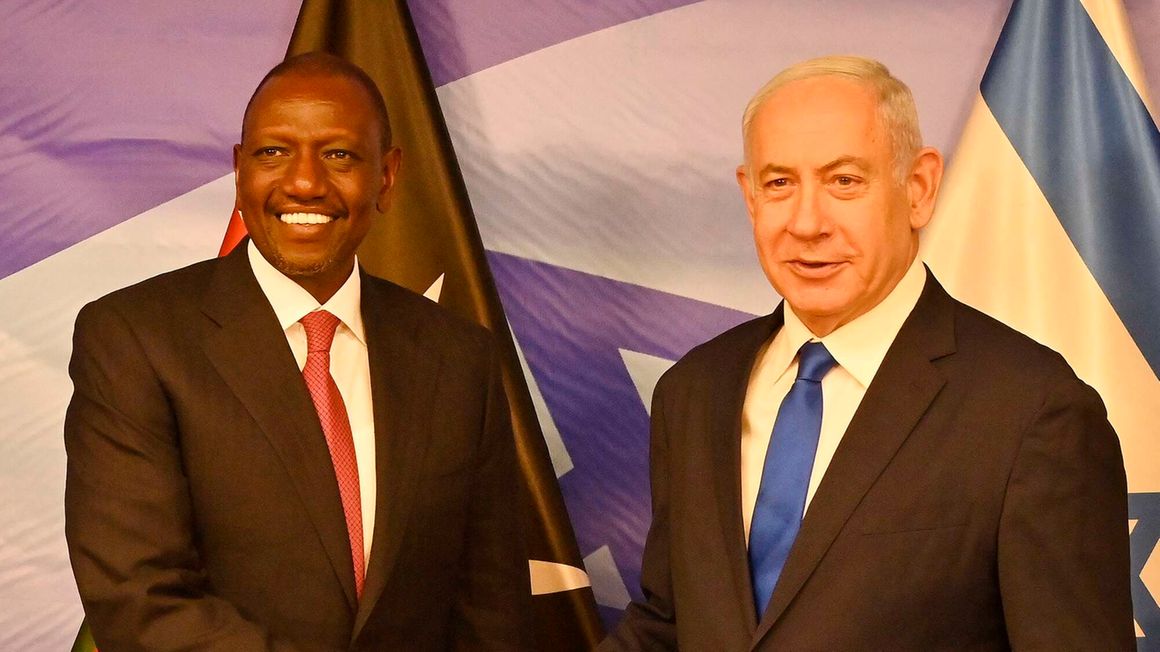
President William Ruto and Israel's Prime Minister Benjamin Netanyahu during a meeting in his office in Jerusalem. FILE PHOTO | PCS
Global investors are becoming increasingly jittery over Kenya’s ability to refinance huge external repayments next financial year following recent delays in payment of a
section of public service employees at a time when the country is dealing with anti-government protests and threats of strikes by workers’ unions.The William Ruto administration admitted last month it was forced to pick repaying debts over the timely release of salaries, signalling the tightrope the Treasury is walking in managing the country’s finance.
Analysts, however, say investors are not fully confident in the government’s pledge to avoid a sovereign default with a huge $2 billion (Sh272 billion) bullet repayment of the debut Eurobond due at the end of the year starting July.
“Policymakers appear willing to honour public debt obligations, but with plenty of pitfalls along the way, officials might not be able to do so — especially with a mid-2024 debt repayment crunch point looming large,” said Virág Fórizs, an Africa-focused economist for UK-based Capital.
“Investors don't appear reassured though; sovereign dollar bond spreads are close to the 1,000-mark signalling debt distress,” Economics wrote in a note on Kenya on May 3.
The yields on Kenya’s 10-year Eurobond maturing June 2024 averaged 19.74 percent last week from 13.7 percent in the last week of March, signalling the rising risk investors are placing on Kenya’s debt.
Treasury Principal Secretary Chris Kiptoo in March reassured lawmakers the government was confident of refinancing the debut Eurobond, ruling out the possibility of a sovereign default.
“The National Treasury will implement Liability Management Operations targeting the 2024 Eurobond maturity to smoothen the maturity structure of public debt over the medium term,” said Dr Kiptoo.
Read: Total stock falls to six-year low on energy sector jitters
The previous administration suspended a similar programme which aims at “lengthening the maturity structure and reducing the refinancing risks in the debt portfolio” last year after investors demanded a double interest rate compared to 2021 for a similar issue.
The Treasury last month made clear its plan to borrow from the persistently tight international capital markets after it opened the bidding process for the lead manager to help it underwrite the next sovereign bond.
“Kenya is tapping the international markets not for new borrowing, but for refinancing purposes and I think if this point is made clear to investors, the floating of the Eurobond will be successful,” Churchill Ogutu, an economist at IC Asset Managers, said on April 19.
Kenya’s elevated risk of debt distress is a result of a persistent large deficit in annual budgets for more than a decade, meaning the country is living far beyond its means.
Kenya ramped up borrowing under former President Uhuru Kenyatta’s administration, in which Dr Ruto served as Deputy, to build infrastructure, leading to a squeeze on its finances as the loans fall due amid criticism over the resulting debt burden.
Debt increased more than four-fold to Sh8.66 trillion under Mr Kenyatta who invested heavily in a new modern railway and links as well as other mega infrastructure such as roads.
Dr Ruto, who partly rode to power on a pledge to make debt a “last resort” in raising funds to fill holes in the budget and not to make the nation “slaves of debt from any place or any country”, has grown debt Sh689.59 billion in six months in office to Sh9.39 trillion last March.
A considerable share of the borrowing is, however, going into refinancing maturing debt amid plans to aggressively ramp up tax revenue receipts.
The current administration has further struggled to implement austerity measures which Dr Ruto said when he took power targeted to cut the recurrent budget as much as Sh300 billion to bring “our country to sanity” where the State does not borrow to “finance recurrent expenditure”.
“The problem is that there are serious question marks about policymakers' ability to keep tightening the fiscal purse strings sufficiently. For one, Kenya's historical track record is weak when it comes to sustained improvements in key fiscal metrics,” Ms Fórizs wrote.
“And crucially, it's not clear to what extent the Ruto administration can deliver additional expenditure savings beyond one-off big-ticket items such as the petrol subsidy scheme.”
Analysts, however, say the unresolved anti-government protests, led by veteran opposition chief Raila Odinga, and threats of a strike by a section of public service workers have put the administration’s austerity programme under pressure.
Further pressure is coming from the implementation of the Bottom-Up Economic Agenda, which proposes to channel resources to sectors that can have a massive impact on creating jobs and wealth.
“So while the authorities are certainly taking debt risks seriously and it is conceivable that the government sticks to the fiscal consolidation path, it is no doubt a narrow one with plenty of pitfalls. We expect at least some slippage,” Ms Fórizs adds.
Read: Economists cut Kenya's growth outlook on poll jitters
“All in all, we don't expect Kenya to opt for a sovereign default. The government seems committed to tackling the country's debt vulnerabilities. And the IMF programme is likely to serve as a fiscal anchor, also providing some comfort to investors.”
→ cmunda@ke.nationmedia.com




No comments :
Post a Comment